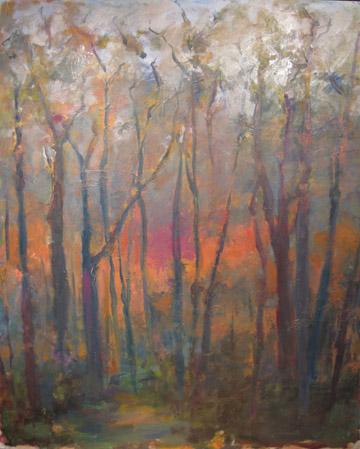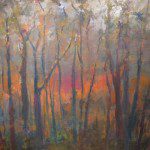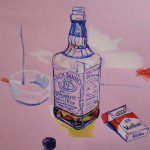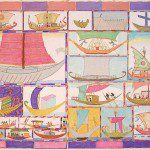Gallery Wrap
By • September 21, 2011 0 1299

Hemphill Fine Arts
Models of Freedom
Contemporary Russian art is not usually an uplifting experience. Decades of social and political turmoil are quick to surface in the works of the artists, who have often battled severe creative persecution and censorship throughout their lives. At the New Museum in New York, for instance, the current exhibition “Ostalgia” (through Sept. 25, 2011) fills the five floors of the museum with harrowing visions, somber memorials, and vivid outcries of a country torn from deep within. While undeniably powerful and of lasting social importance, it can all leave you feeling weak, even incapacitated.
And so the work of Russian artists Ilya and Emilia Kabakov is a welcome contrast. In the exhibition’s strongest works, Hemphill showcases the artists’ monumental public work proposals, offering a vision of a fruitful, dynamic future.
Beginning his career as a government-sanctioned children’s book illustrator in 1950s Moscow, Ilya Kabakov secretly pursued private works on his own time, exploring societal transitions between construction and decline. Since 1988, Ilya has worked collaboratively with partner Emilia, and the resulting work is rooted in a social conviviality, focused on education and shared public spaces. In a model of the Kabokov’s renowned large-scale traveling sculpture, “The Ship of Tolerance,” first built in Siwa, Egypt and to be presented in Miami this December, an ancient Egyptian vessel is adorned with sails stitched together from paintings of hundreds of local school children from different ethnic and social backgrounds, teaching children the value of different cultures and ideas. In “The Large House of Humanity,” they offer a stunning model and proposal for an empty park area across the Potomac from Washington, to be equipped with green space, a large performance stage, small museums and educational centers. As made clear from the work, these artists are devoted to the growth of social knowledge, ideas and liberty. It is work that deserves to be seen.
“KABAKOV: Ilya & Emilia Kabakov,” will be on display at Hemphill Fine Arts through Oct. 29. 1515 14th Street, NW # 300. HempHillFineArts.com.
Heiner Contemporary
Waiting for a Hollywood Ending
The Heiner Contemporary gave artist David Kramer more than just an exhibition. They gave him control of the entire gallery.
Deeply affected by the cultural clichés, Hollywood ideals, and advertisements he grew up with in the 1970s, Kramer’s work explores the disillusionment of adulthood, while still filled with humor, sincerity and wisdom.
Walking into the gallery, you enter a stylish, nuclear-colored 1950s living room, complete with faux stonewall facing and pod-shaped furniture. Kramer’s paintings, almost littering the walls, offer nostalgic freeze-frames from the era, long lost but never quite forgotten. Men and women lie in each other’s arms with stiff drinks and swirling cigarettes. A stylish gathering of erudite young couples basks in the parlor with all the comfort money can buy. There are also cowboys, nude women behind flowers, family portraits, picnics beside Cadillac convertibles, and so on in that fashion. The entire color palette recalls a bag of Skittles.
Though Kramer is clearly a master draftsman, the paintings are executed with an intentional crudeness and injected with ironic, pithy quips and personal aphorisms of the artist. In one painting, a couple lounges together lovingly with wine, cigarettes and coffee, and across the paper is written, “Why is it that the things I love most…Are the very things that are going to end up killing me.”
The furniture likewise seems a bit off—if functional—until you realize that the artist built everything, from the lamps, to the tables, to the wall, by hand. The gallery will host a performance by the artist and party on Saturday, Sept. 24 from 4:30 to 7:30 p.m.
“Prequel to the Sequel: Waiting for the Hollywood Ending,” will be on display at Heiner Contemporary through Oct. 22. 1675 Wisconsin Avenue NW. HeinerContemporary.com
Addison/Ripley Fine Art
The Literature of Landscape
It is clear in the work of painter Mary Page Evans that the landscape genre is very much alive. The conviction and fluidity of her brush strokes, her intuitive sense of the textures of land, sky and sea, and her pure, unfiltered observation are nothing other than the culmination of years devoted to mastering this artistic tradition.
Addison/Ripley Fine Art is exhibiting a large body of new works by this prolific regional artist. In her recent paintings, Evans has taken the ocean swells, rolling hillsides, and lush forests of the East Coast, and broken down the planes and surfaces into a cohesive, undulating rhythm of color and texture.
There is an expansiveness and allusion in her bold, loose brushstrokes that is almost literary, referencing a history of predecessors, from her mentor Gene Davis—of the Washington Color School of painters—to Monet, de Kooning, and renowned landscape painter Richard Mayhew (whose work is currently on view at the Parish Gallery in Canal Square). The only equivalent to experiencing the graceful, fluid work of this artist would be to walk through the Shenandoah Mountains or explore the windy coastline of the Virginia shore. But this sure is a lot closer to home.
“Skies, Trees and Sea,” the artwork of Mary Page Evans, will be on display at Addison/Ripley Fine Art through Oct. 15. 1670 Wisconsin Avenue NW. AddisonRipleyFineArt.com
- “Life Tree” by Mary Page Evans, at Addison/Ripley Fine Art






